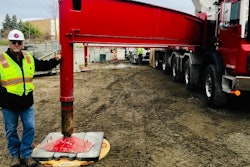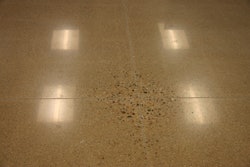
AJ’s Concrete Pumping, a division of Sutherland Concrete, operates a fleet of Putzmeister truck-mounted Z-boom pumps ranging from 58- to 24-meter, as well as High-Pressure Line Pumps. Since the mid-1970s, the company has provided placing and finishing services for high-end residential homes, mill installations, commercial high rises, and warehouse/tilt up slabs measuring up to 35,000 sq. ft in a single pour. With two locations, the company serves the Lower Mainland of British Columbia, and downtown Vancouver.
Lemonade out of Lemons
About 10 years ago, all the factory-supplied aluminum outrigger pads were stolen off of six concrete pumps in AJ’s fleet. Previously, Scott Sutherland, Operations Manager, had seen information about SafetyTech Outrigger Pads in an online message board for concrete contractors. Intrigued, Sutherland purchased an initial set of SafetyTech Outrigger Pads. “We used to build our own wooden outrigger mats, which we had to replace every October because they rot in the wet conditions we work in,” he says. “Over the years, we couldn’t have been happier with our SafetyTech Outrigger Pads. We haven’t had to replace a set since.”
“SafetyTech Outrigger Pads have been a key part of our ability to setup safely since we added them nearly 10 years ago. We invest in the best tools and training to ensure not only an efficient concrete pour every time, but also a safe concrete pour. DICA’s engineered products help to ensure safe, and consistent setups of our equipment wherever we are working,” says Sutherland.
Environmental Challenges
Flash forward 10 years, and AJ’s began to consider another setup challenge it faced. “In the area we serve, we have three very different types of scenarios that require different solutions. Much of the region is on a river delta, it’s flat, but the ground conditions are terrible,” he says. “The second challenge is the mountainous terrain and working on unlevel sloped conditions. We have to setup on some nasty slopes,” And the third challenge is working in downtown Vancouver. “Because of the crowded conditions, we often have to setup right at the edge of the excavation.”
To conquer the poor ground conditions, Sutherland sought help from DICA for a product that would provide even greater rigidity over a larger area, while having similar weight and ergonomic features. “We were looking for a SafetyTech Pad like product that had greater rigidity when the boom size and ground conditions required it. DICA introduced us to their FiberMax Outrigger Pads,” says Sutherland. “We started with the 1.5” thick multi-piece set-up and loved the configuration and the performance. The pads were constructed of a very hard material that was extremely stiff and had no noticeable flex. They were a bit heavier than what we wanted, so DICA worked with us to develop a 1.0” version which ended up being the perfect blend of manageable weight and performance. It’s hard to overstate how tough and durable FiberMax Pads are. They’re basically bulletproof, and more than meet our needs for rigidity and performance.”
A New Safety Tool
To round out his set-up needs, Sutherland needed an engineered cribbing solution to gain height when operating in challenging unlevel conditions, and one that would stand up to Sutherland’s stringent safety standards. “We started bugging Kerry Koberg (DICA’s Strategic Accounts Manager) to come up with a cribbing solution two years before ProStack came out,” notes Sutherland.
DICA’s interlocking ProStack Cribbing blocks provide six inches of height per stacked level, and were the perfect solution for gaining the height they needed. By interlocking together, ProStack cribbing can be stacked to provide a safe solution in situations where the ground is not level and additional height is needed. The more load you exert, the tighter the blocks lock together. ProStack cribbing blocks are designed for equipment with outrigger loads up to 110,000 pounds, such as concrete pumps, boom trucks, digger derricks, and aerial devices. “We use ProStack on eight out of 10 jobs in the mountainous regions. My operators love the cribbing blocks, and the wedges. They are so efficient for leveling the cribbing stack on a slope. “
But it is in the city where ProStack has more than paid for itself. Working near an excavated foundation requires equipment to be set back and the ground to be prepped with gravel. However, operating in confined spaces makes this a tricky business. The further back from the foundation you go, the more expensive the ground prep for the customer, and many times a bigger pump is required. With ProStack providing the height and support needed, AJ’s operators can set up directly in the excavated area. “With ProStack set-up in the excavated area, there is no more guesswork by the operator as to the appropriate set back needed. It cuts setup time, it’s safer, and it creates a revenue opportunity for us,” says Sutherland. “Customers don’t question the solution because its professional, promotes safety, and it saves them money by eliminating the need to bring in back fill and larger more expensive equipment.”
Before ProStack, operators grabbed timbers from the yard to use for cribbing. “We had to trust the crews to use good stuff, not timbers that were rotten. With ProStack we have zero fail rate, zero wear and tear, and we take the liability off the shoulders of the operator,” explains Sutherland.
The Return on the Investment
“Concrete pumping is very competitive in our market. Products like ProStack help us stay ahead of the curve, and it gives us a professional appearance,” says Sutherland. Not only does ProStack deliver productivity and efficiency for AJ’s crews, they have peace of mind in a fully engineered solution. “DICA’s published load ratings and usage guidelines give us the confidence we need and the documentation the authorities and customers are looking for. Having engineering letters to show local safety regulatory inspectors is important. Documentation is key.”
Since buying that first set to try out, AJ’s Concrete Pumping has added ProStack to another eight pumps. “It’s actually a money maker for us,” Sutherland explains. “Cribbing usage fees are typically included in setup charges to customers. And customers are happy, because this is less expensive than the alternative in most cases. After using it 10 times, it is paid for and we start making money on it.”


















